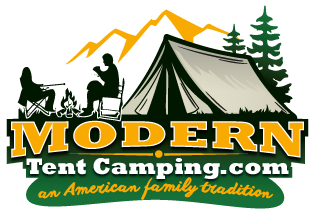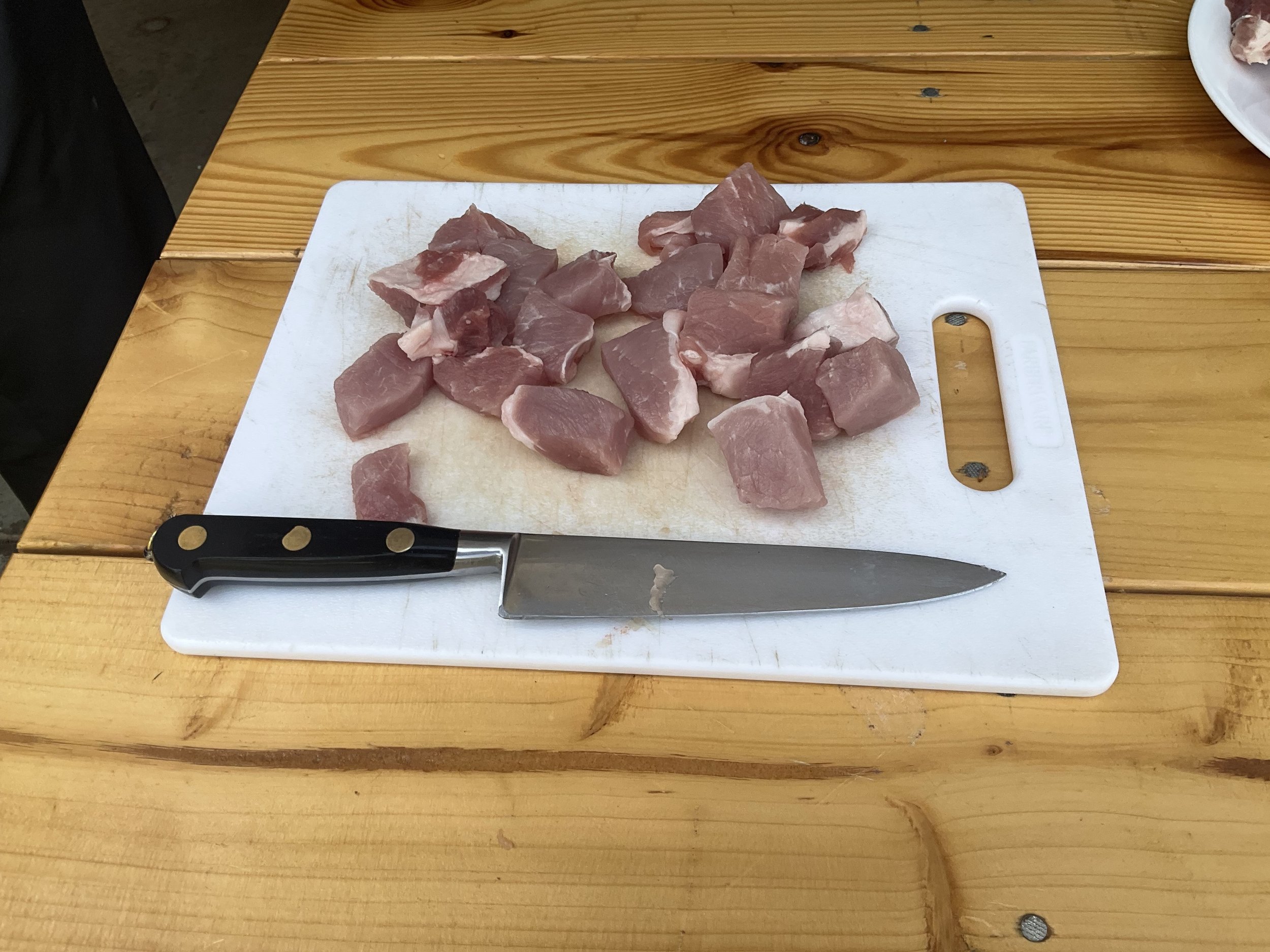Find a Good All-purpose Kitchen Knife
Since most camping families don’t have a lot of packing space, they should find a good mid-size, general-purpose, camp kitchen knife that can easily cut most of of the meat, fruits, vegetables, and bread needed to prepare most camp meals. More specifically, this camp kitchen knife should be: 1. large enough to cut large melons, 2. strong enough to cut cabbages & hard root vegetables, and 3. sharp enough to thinly slice tomatoes & fresh bread — but, it should also be 4. small enough to pack with other kitchen utensils & 5. cost less than $50.
Unfortunately. such a knife is hard to find. Chef’s knives and butcher knives are too big. Pairing knives are too small and too thin. Hunting knives and survival knives are too thick and have saber or scandi grinds that don’t slice well. And folding knives are too weak in the folding joint and could close up on your hand. A good kitchen knife should fall between these extremes. The best options are large, straight-edged (non-serrated) steak knives but these knives are hard to find. Here are a few knives on the web that would make good general purpose camp kitchen knives for less than $50.
Best All-Purpose Camp Kitchen Knives - 2025
In my opinion, the best all-purpose camp kitchen knife is a mid-size knife with a total length of 9 to 10.5 inches, a thin, straight (not serrated) blade length of 4.5 to 6 inches, a width of 1 to 1.5 inches, and a spine thickness of 1.5 to 3 mm. When you buy one of these knives, or any other knife for your kitchen, sharpen the edge bevel to 18 degrees for maximum slicing effectiveness. After sharpening it, hone and/or strop it frequently to keep the edge sharp.
Vintage sabatier small chef knife - $40
Can find this knife on EBay and in some antique/thrift stores. Strengths: good blade length, good balance, flat grind makes a good slicing knife, finger guard, stainless steel blade & reasonable price. Limitations: small handle, small belly & no sheath.
Dalstrong Gladiator Non-Serrated Steak Knife - $25 with edge guard
Strengths: Thin Granton-edge blade produces maximum slicing and peeling effectiveness, stainless steel blade, & comes with an edge cover, good blade length, full forward belly, comfortable handle. Limitations: must be bought as a set of 4 for $100, & soft steel edge requires frequent stroping or honing.
Large Asian-made non-serrated steak knife - $30
Can buy from discount department store or Amazon. Strengths: good blade length & shape, good grind for slicing, stainless steel, economical price. Limitations: small handle, no sheath, may have to buy as a set of four.
The vintage Sabatier small chef knife makes a good all-purpose knife. Buy it from a thrift or antique store or from EBay.
The Dalstrong Gladiator non-serrated steak knife makes a good all-purpose kitchen knife. But it must be purchased as a set of 4.
Dexter Russell Green River 2212 - $25.
Strengths: Economical price, thin 2.0 mm flat ground blade is an excellent slicer, total length 8.5 inches will pack well with other kitchen gear, blade length (4.5 inches) is long enough to cut most foods but short enough to control, heel width is 1.0 inch, & weight is 3.5 oz. Limitations: Short 3.9 inch rough handle is uncomfortable & must be sanded, does not come with a sheath, carbon steel blade requires extra care, & bullnose tip does not pierce cabbage & melons easily.
Opinel SS #10 Folding Knife, $20.
Makes a great back-up food-prep knife but would not choose it as my primary food-prep knife. Strengths: Economically priced, thin (1.9 mm) flat grind stainless steel blade makes a great slicing knife, packs into small space, lightweight, folding design does not need a sheath. folded length (5.0 inches) can easily be packed with kitchen gear, blade length is 4.0 in, handle length 4.5 in, weight 2.3 oz. Limitations: Not strong enough to easily cut large & dense foods. heel width of 0.75 inches limits chopping effectiveness, small pivot point is not as strong as a fixed blade knife, could break or fold up on hand, requires more effort to clean.
River Traders French Ball Knife $60 with sheath.
Strengths: Very comfortable 4.25 inch maple handle, great feel & balance, thin 1.6 mm flat-ground blade great for slicing most foods, total length (9.25 in) packs well with other kitchen gear, blade length is 4.75 in, heel width is 1.25 in, weight is 3.5 oz. Limitations: price & carbon steel (1095) blade requires extra care.
The Dexter Russell Green River knife makes a good all-purpose camp kitchen knife. But the small point makes it hard to pierce millions and cabbage.
The River Traders French Ball knife is a great all-purpose camp kitchen knife but it cost $60.
Tips for buying a camp kitchen knife
Here is a list of features to consider before buying an all-purpose food-prep camp kitchen knife.
Essential Features
Stainless steel for easy maintenance.
Overall length should be no more than 10.5 in. to fit with other utensils.
Edge should be straight NOT serrated for easy sharpening.
Point should be sharp for piercing hard foods.
Blade should be about 5 in long for versatility, control & safety.
Rear edge (heel) should be about 1.25 in. wide for chopping.
Front edge (belly) should be curved for slicing.
Blade should be no more than 3/32 in. thick for slicing.
Grind should be full flat or full hollow for slicing.
Should have a sheath to protect edge, other utensils & users.
Desirable Features
European-style rather than Japanese-style.
Should have a full tang for strength and good balance.
Tang should be tapered or drilled to reduce weight.
Should weigh 4 to 6 oz. for cutting large, dense foods.
Rockwell HRC = 55 to 60 to keep sharp.
Straight back for versatility.
Handle length 4 to 5 in for comfort.
Handle circumference 3 to 5 in. for comfort.
Birds beak or pommel swell to prevent slipping.
Wood, bone, stag, or white micarta for traditional look.
Copper rivets, iron pins, or brass pins for traditional look.
Should be priced less than $50.





